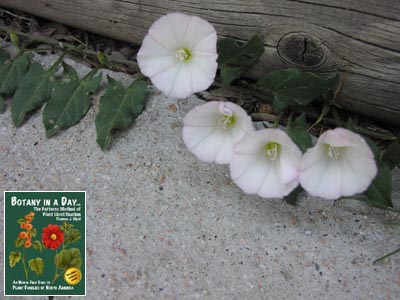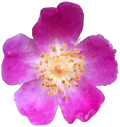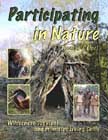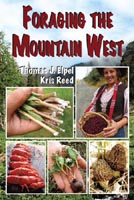Field Bindweed
(Convolvulus arvensis) Morning Glory Family
By Pamela G. Sherman. Edited by Thomas J. Elpel

About Field Bindweed: Field bindweed is a creeping vine. It is a ground cover over bare ground or short grass and a climber where there is competition. It climbs the stems of other plants and grasses, producing what looks at first sight like a strange new plant. Field bindweed is pollinated by bees, flies, and it is self-fertile, the flowers being hermaphroditic (having both male and female organs on the same plant).
Field bindweed is considered a relatively poor competitor for light, despite its climbing propensity. Its root system, however, is comprised of many shallow horizontal roots and a few deep vertical ones, reaching down more than 20 feet, enabling the plant to outcompete other plants for limited soil moisture in a dry area, according to Dr. Larry Mitich of the Weed Science Society of America. This extensive root system can also be initially useful in "binding" soil-- stabilizing steep, erosion-prone hillsides and other areas. [1]
Bindweed spreads mostly from its roots and rhizomes' adventitious buds. Roots as far down as 4.3 m [over twelve feet] can bud [1]. Fragments of vertical roots as small as 5 cm [just under an inch and a half] can bud... at 38 to 76 cm [about 15 to 30 inches] from the parent plant, a lateral often turns downward, becoming a secondary vertical root; it then sends out new roots and shoots... [1]. One field bindweed plant can spread radially more than 3 m [9 feet] in a growing season [1]. The rhizomes also can cover 25 m2 in a season [75 sq. feet] [1].
The average field bindweed plant produces about 550 seeds [1]. Within one month after forming, the seed coat matures and becomes impervious to water [1]. The seeds can withstand silage and soaking, mammal and bird digestion , heat, and fumigation with methyl bromide. [1]. They can remain viable in the stomachs of some migrating birds for up to six days [1]. Scientists who plant bindweed seeds for experiments must scarify them by soaking in concentrated sulfuric acid for an hour. [1] In 50-yr old bindweed samples 8% germinated, 54% were still impermeable, and only 38% were dead [1].
 History: Dioscorides, a much-quoted ancient Greek medical herbalist, wrote about field bindweed in the first century A.D. Even at that time it had several names in every country around the Mediterranean, indicating its ubiquity... Greeks called it `circling plant' [1]; one of its Greek names is clymenon. [for grins, say that out loud; it well describes what field bindweed does.] Romans called it volucrum majus... "a large worm that wraps itself in vines" [1]. In 1753 Linnaeus gave it the name Convolvulus arvensis, "entwining plant of the field." [1] The word "byndweede" is in print by the mid-1500s, by which time the plant was already causing consternation. [1] Bindweed has also popularly been known as "devil's guts, creeping Jenny, European bindweed, hedge bells, corn lily...laplove, sheepbine, corn-bind, bearbind, green vine, possession vine, lesser bind-weed, and many variations on morning glory." [1]
History: Dioscorides, a much-quoted ancient Greek medical herbalist, wrote about field bindweed in the first century A.D. Even at that time it had several names in every country around the Mediterranean, indicating its ubiquity... Greeks called it `circling plant' [1]; one of its Greek names is clymenon. [for grins, say that out loud; it well describes what field bindweed does.] Romans called it volucrum majus... "a large worm that wraps itself in vines" [1]. In 1753 Linnaeus gave it the name Convolvulus arvensis, "entwining plant of the field." [1] The word "byndweede" is in print by the mid-1500s, by which time the plant was already causing consternation. [1] Bindweed has also popularly been known as "devil's guts, creeping Jenny, European bindweed, hedge bells, corn lily...laplove, sheepbine, corn-bind, bearbind, green vine, possession vine, lesser bind-weed, and many variations on morning glory." [1]
Range: "Field bindweed is found throughout the temperate zone,... in the Himalayas at altitudes of 3048 M (10,000 ft) ... and is reported in 32 different world crops, principally corn, small grains, sugarbeets, and vineyards...It's native to Europe and Asia..." [1] Field bindweed "has an impressive array of survival techniques which has enabled it to become one of the world's 10 worst weeds." [1] It most likely hitched a ride to the U.S. with grain and garden seeds; it has also been planted as an ornamental...in hanging baskets and as a cover crop. [1] In 1739 Virginia, written records mention it. [1] By the early 1800s, it was all along the eastern seaboard... [1]. It came West via railroads, crop seed, and pioneers. [1]
At the outbreak of the Civil War, bindweed was becoming troublesome, though it was still planted occasionally as an ornamental. In 1859 Union supporter William Darlington compared bindweed management to the maintenance of civil rights: "We are told that incessant vigilance is the condition on which alone the rights of freemen can be maintained...I believe the farmer will find a similar condition annexed to the preservation of his premises [from bindweed]." [1]
Livestock and Bee Uses: In India bindweed is used as a feed supplement for livestock. One report indicates that bindweed has a higher percentage of protein than Lucerne [Alfalfa] or cowpea. [1] Grazing can both benefit sheep and help control bindweed.[1] According to an Oklahoma Cooperative Extension Service fact sheet: "Bindweed or tie vine is a very valuable honey plant in many sections of Oklahoma, especially on rich alluvial soils. This plant produces a surplus of white honey." [2]
Edibility: When accidentally ground with flour, bindweed seeds give an unpleasant taste and color to the flour. [1]
Medicinal Uses: Native American researcher Daniel Moerman notes that the Ramah Navajo made a cold infusion of field bindweed and used it as a lotion to heal spider bites. If the spider had been inadvertently swallowed, field bindweed was then deliberately ingested with food. Pomo women used a decoction of plant or stem with leaves for excessive menstruation. [3] In India, bindweed is used as a purgative. [1]
A study published in PubMed.gov found "some new evidence on remarkable...activities" of Convolvulus arvensis in inhibiting cancer growth and leishmaniasis, an ulcerative skin disease which afflicts 12 million people in warm areas of the planet. [4] A separate study published in PubMed.gov concluded that "[h]igh molecular mass extract [of Convolvulus arvensis] deserves further study as an anti-cancer agent." [5] The American Cancer Society's Cancer Survivor's Network has a brief discussion of promising anti-cancer research with respect to Convolvulus arvensis. [6] A study on the effect of this plant's dried extract found that it can be used as a natural food antioxidant. [7]
A study investigating the medical properties of the Morning Glory family as a whole concluded that research in many countries over the past 28 years has shown this family has useful medicinal properties, but it is not economically viable to industrially extract and sell the compounds, so scientists are trying "to mimic the isolated natural compounds synthetically, studying the biological activity and the side effects of the synthetic compounds." [8]
Other Uses: A green dye is obtained from the whole plant. [Plants for a Future] The Okanagan-Colville tribes used the stems as a "pack rope" for carrying birds and marmots home after hunting. [3] Other sources say this cordage is "flexible and strong, but not long-lasting." [9]
Biological Controls: Field bindweed gall mites, Aceria malherbae, are reported to have done a good job in drier areas. They do not work in wet conditions. [10]
Grazing: Sheep and cattle, hogs and chickens eat the leaves and stems...hogs and chickens...also expose the roots and crowns as they eat, which further depletes root reserves.(Stahlman, 1984)
Competition: Bindweed is not competitive with tall, shade-producing plants. "In 1985, The New Farm magazine featured a farmer in Fort Collins, Colorado, who used pumpkins and banana squash as a cheap bindweed "herbicide."(Mattingly, 1985) The farmer, John Mattingly, allowed the bindweed to germinate in spring then tilled the field. In June he planted pumpkins. He fertilized with liquid nitrogen injected through the irrigation water, which stimulated the pumpkins' leaf and vine growth."
"Within a few weeks, the bindweeds were shaded and strangled by the pumpkins so badly that they produced no seed. After pumpkin harvest, he disked down the pumpkin vines. Mattingly suspects that there is a chemical in the pumpkin vines that discourages bindweed, because he's had no bindweed in his pumpkin field for nine years. (Mattingly, 1985)" [11]
Smothering: Use black plastic mulch or fabric weed barrier to knock back bindweed by removing the foliage, thus eventually starving the roots... This may take three to four years.
Mechanical Control: According to ATTRA, The National Sustainable Agriculture Information Service, it's necessary to repeatedly pull the top growth to deplete the roots' energy reserves.
Least-Toxic Herbicides: "There are several new herbicides made from natural substances such as acetic acid, clove oil, thyme oil, and soap...Several acetic acid (vinegar) based herbicides have been developed for non-selective post-emergent use"...Acetic acid herbicides work best when used in the sun... [11]
Sources:
- [1] Dr. Larry Mitich of the Weed Science Society of America: http://wssa.net/weed/intriguing-world-of-weeds/#x
- [2] Oklahoma Cooperative Extension Service fact sheet: http://pods.dasnr.okstate.edu/docushare/dsweb/Get/Document-2288/EPP-7155.pdf
- [3] Moerman, Daniel E. Native American Ethnobotany (Portland: Timber Press, Inc.,1998)
- [4] Mahmoudi M, Zamani Taghizadeh Rabe S, Zamani Taghizadeh Rabe S, Emami SA: A study to investigate the biological activity of proteoglycan mixture extract from Convolvulus arvensis; http://www.ncbi.nlm.nih.gov/pubmed/25324459
- [5] Meng XL1, Riordan NH, Casciari JJ, Zhu Y, Zhong J, González MJ, Miranda-Massari JR, Riordan HD Effects of a high molecular mass Convolvulus arvensis extract on tumor growth and angiogenesis. http://www.ncbi.nlm.nih.gov/pubmed/12572240
- [6] Cancer Survivor's Network of the American Cancer Society: http://csn.cancer.org/node/221679
- [7] Nurul Aini Mohd Azman 1,2, Maria Gabriela Gallego 1, Luis Juliá 3, Lluis Fajari 3 and MaríaPilar Almajano 1,* The Effect of Convolvulus arvensis Dried Extract as a Potential Antioxidant in Food Models published on the website of the Multidisciplinary Digital Publishing Institute http://www.mdpi.com/2076-3921/4/1/170/htm
- [8] Amani S Awaad1*, Asmaa A Al-Rifai2, Reham M El-Meligy2, Ahmed M Alafeefy3 and Saleh I Alqasoumi4 : Antiulcerogenic Activity of Convolvulus Species Austinpublishinggroup.com/chromatography/download. php?file
- [9] Plants for a Future: http://www.pfaf.org/user/Plant.aspx?LatinName=Convolvulus+arvensis
- [10] Colorado State Extension Service http://www.colostate.edu/Dept/CoopExt/Adams/weed/pdf/BindweedMite.pdf
- [11] ATTRA, The National Sustainable Agriculture Information Service, developed and managed by the National Center for Appropriate Technology (NCAT): https://attra.ncat.org/attra-pub/viewhtml.php?id=141
- Dr. James Duke: http://www.ars-grin.gov/cgi-bin/duke/ethnobot.pl
- Montana Plant-Life.org: http://montana.plant-life.org/species/convolv_arvens.htm
Return to the Weed Profiles Table of Contents
Return to the Wildflowers & Weeds Home Page.




 History: Dioscorides, a much-quoted ancient Greek medical herbalist, wrote about field bindweed in the first century A.D. Even at that time it had several names in every country around the Mediterranean, indicating its ubiquity... Greeks called it `circling plant' [1]; one of its Greek names is clymenon. [for grins, say that out loud; it well describes what field bindweed does.] Romans called it volucrum majus... "a large worm that wraps itself in vines" [1]. In 1753 Linnaeus gave it the name Convolvulus arvensis, "entwining plant of the field." [1] The word "byndweede" is in print by the mid-1500s, by which time the plant was already causing consternation. [1] Bindweed has also popularly been known as "devil's guts, creeping Jenny, European bindweed, hedge bells, corn lily...laplove, sheepbine, corn-bind, bearbind, green vine, possession vine, lesser bind-weed, and many variations on morning glory." [1]
History: Dioscorides, a much-quoted ancient Greek medical herbalist, wrote about field bindweed in the first century A.D. Even at that time it had several names in every country around the Mediterranean, indicating its ubiquity... Greeks called it `circling plant' [1]; one of its Greek names is clymenon. [for grins, say that out loud; it well describes what field bindweed does.] Romans called it volucrum majus... "a large worm that wraps itself in vines" [1]. In 1753 Linnaeus gave it the name Convolvulus arvensis, "entwining plant of the field." [1] The word "byndweede" is in print by the mid-1500s, by which time the plant was already causing consternation. [1] Bindweed has also popularly been known as "devil's guts, creeping Jenny, European bindweed, hedge bells, corn lily...laplove, sheepbine, corn-bind, bearbind, green vine, possession vine, lesser bind-weed, and many variations on morning glory." [1]





